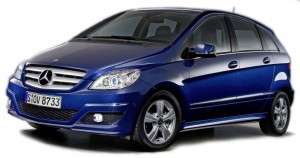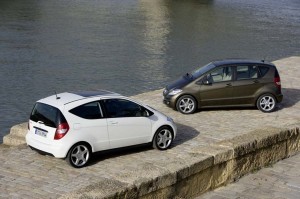Mercedes-Benz plans to double the number of vehicles it offers in the A- and B-Class segments by the end of 2011, Daimler AG chief executive officer Dieter Zetsche told the company’s shareholders.
“By the end of next year, we will offer four models in our current A-Class and B-Class segments instead of the previous two. Each of these models will demonstrate that a small Mercedes also can thrill customers,” Zetsche said as he spoke at the company’s annual meeting.
“We are very happy to have the A-and B-class class vehicles in the portfolio,” Zetsche said, adding they help Mercedes meet new regulations mandating substantial cuts in C02 emissions, which are forcing carmakers of all kinds to re-shape their product lines.
The Daimler CEO stressed that unlike small cars of the past, the new models “will be profitable,” as well. That’s a significant issue in the luxury market, where buyers have traditionally equated size with worth.
“We will base all four successor models of the A-Class and B-Class on largely identical vehicle architecture, while simultaneously ensuring maximum product differentiation for our customers,” Zetsche said.

Mercedes' future small cars -- the current B-Class is shown here -- could benefit from the company's new partnership with the Renault-Nissan Alliance.
The A-Class and B-Class successor generations will be built plants in Rastatt and in Hungary, saving Mercedes Benz nearly $250 million. The new models, meanwhile, could benefit from Daimler’s new relationship with the Renault-Nissan Alliance. The Euro-French affiliate has agreed to assist the Germans in developing smaller vehicles – notably for Daimler’s Smart brand – and to provide some small powertrains for use in future models where fuel efficiency is a critical selling point.
“This year will once again reduce the fuel consumption of our entire vehicle fleet,” Zetsche said. “Contributing to this development will be our completely new six and eight cylinder engines, (along with) the 7G-tronic,” a seven-speed automatic transmission optimized for fuel efficiency, and the ECO- start/stop function, “which we will roll out for all Mercedes-Benz passenger cars, beginning this year,” Zetsche said.
With government regulators breathing down the corporate backs of luxury makers like Mercedes, it’s no surprise Zetsche declared Daimler will be “consistently improving” its fuel efficiency. Among other steps he outlined that should assist that effort are vehicle weight reduction. Mass, engineers are fond of saying, is the enemy of fuel economy.
Surprisingly, despite all the focus on engineering, Zetsche revealed Daimler actually reduced its overall spending on research and development in 2009. But most of the decrease, he said, was the result of salary cuts rather than any reduction in R&D activity.

